Papers by Michael O'Connell

Springer eBooks, 1993
1. Results are presented of palaeoecological investigations at Derryinver Hill, an important arch... more 1. Results are presented of palaeoecological investigations at Derryinver Hill, an important archaeological site in the Renvyle Peninsula, Connemara, western Ireland. 2. Four short radiocarbon-dated pollen diagrams have enabled land-use history on the Hill during late prehistory and the early historical period to be reconstructed in considerable detail. 3. It is shown that pre-bog walls on the Hill — the first to be dated in Connemara — were laid out at 2400 BP, but it was not until 1700 BP that peat accumulation began locally. 4. The evidence indicates that, though grassy heath conditions existed prior to the stone wall construction, peat initiation was retarded through land-use management. When management ceased, the grassy heathland gave way to blanket bog. 5. These findings are discussed in the light of results from a long radiocarbon-dated peat pollen profile from the base of Derryinver Hill and of other palaeoecological investigations in north-western Connemara.
Terra Nostra, 2001
O'Connell, M and Molloy, K and Holmes, JA and Jones, R and Leuenberger, M and Eicher, U and ... more O'Connell, M and Molloy, K and Holmes, JA and Jones, R and Leuenberger, M and Eicher, U and Schettler, G and Saarinen, T and McDermott, F and van der Plicht, J and Chambers, FM and Hunt, JB and Daniell, JRG and van Geel, B and Haas, JN and Dalton, C (2001) Evidence from the TIMECHS project for climatic instability during the early Holocene at the Atlantic fringe of Europe. Terra Nostra , 2001/3 159 - 161. ... Full text not available from this repository. ... Evidence from the TIMECHS project for climatic instability during the early Holocene at the Atlantic ...

The Holocene, 2017
The results of radiocarbon dating and dendrochronological investigations of timbers (mainly pine ... more The results of radiocarbon dating and dendrochronological investigations of timbers (mainly pine and oak) preserved in coastal peats on the Atlantic coast of mid-western Ireland are reported. These are complemented by the results of pollen analytical investigations, including a detailed pollen profile from Lough Atalia, a brackish lake located within present-day Galway city and immediately to the east of the medieval town. The results from the fossil timber investigations show that pine stumps exposed on coastal intertidal peats in mid-western Ireland date mainly to ca. 3000 BC, that is, they are coeval with the so-called ‘pine flushes’ on blanket bog in western Ireland. Many of the oak timbers are considerably older while an oak on peat in Turlin Bay, near Silverstrand, persisted until ca. 2100 BC. This fossil timber record, taken in conjunction with the pollen records, suggests conditions very different to those pertaining at present, including absence of direct marine influence b...

Geographies, 2021
Palaeoecological investigations, involving pollen analysis, dendrochronology, and radiocarbon dat... more Palaeoecological investigations, involving pollen analysis, dendrochronology, and radiocarbon dating of bog-pine, provide the basis for reconstruction of vegetation dynamics, landscape development, and human impact in two contrasting parts of lowland northern Connemara, western Ireland, namely Ballydoo and Derryeighter in the east, and Renvyle/Letterfrack/Cleggan at the Atlantic coast some 40 km to the west. The history of Scots pine (Pinus sylvestris) is traced in detail. Standout features include the dominant role the tree played from the early Holocene onwards and especially at Ballydoo, its ability to grow on peat surfaces (so-called pine flush) over the course of several millennia during the mid-Holocene (centred on c. 5 ka), and its demise in a three-step fashion to become regionally extinct at c. 2.3 ka. The factors influencing these developments, including climate change, are discussed. Another natural phenomenon, namely the spread of blanket bog, is shown to be an on-going ...

Review of Palaeobotany and Palynology, 2021
Holocene vegetation dynamics of mid-western Ireland are discussed with particular reference to th... more Holocene vegetation dynamics of mid-western Ireland are discussed with particular reference to the Galway and Mayo uplands, the development of upland blanket bog and the history of pine and yew. A detailed pollen profile from Mám Éan (Maumeen), a corrie lake, provides insights into environmental change in upland Connemara where, in recent decades, overgrazing and peat erosion have given rise to serious environmental concerns. Vegetation dynamics are broadly comparable to those in lowland Connemara and also upland sites in the Nephin Begs, Co. Mayo. The available evidence suggests corrie glaciation in the Younger Dryas. The oldest sediments show the usual early Holocene progression from open herbaceous communities to woody vegetation dominated by juniper, tree birch, and finally hazel. Tall canopy trees then spread, including pine, and elm and oak, and later alder (at ca. 7.7 ka). In the interval 10.2-4.8 ka, pine was dominant and for much of this time fires were frequent. There is a distinct mid-Holocene Elm Decline and a short Neolithic Landnam phase that is followed by woodland regeneration involving, at first, mainly pine and later yew. 14 C dating of bog-pine from upland sites sheds new light on pine and upland blanket bog development in the mid-Holocene. It is shown that while blanket bog was initiated at Mám Éan by ca. 10.8 ka, the present-day treeless landscape has come about within the last 1000 years as a result of sustained human impact, that has also resulted in severe erosion of minerogenic and, more recently, peaty soils.
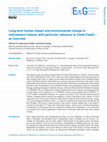
E&G Quaternary Science Journal, 2020
This paper presents new palaeoecological data from north County Mayo (Co. Mayo), western Ireland,... more This paper presents new palaeoecological data from north County Mayo (Co. Mayo), western Ireland, and reviews published data with a view to achieving a better understanding of the timing and nature of early farming in the region, its impact on the natural environment, and the factors, including climate change, that influenced mid-and late-Holocene vegetation dynamics and farming in the region. A long pollen profile from Glenulra, a deep basin situated within Céide Fields, and short profiles from blanket peat that overlies the prehistoric stone-wall field system provide unambiguous evidence for substantial farming, including widespread woodland clearance, in the early British and Irish Neolithic (beginning ca. 3800 BCE). This was followed by a distinct lull that lasted several centuries until farming activity resumed again, at first modestly (at ca. 2700 BCE) and then more markedly from 2350 BCE, i.e. at the Neolithic-Chalcolithic transition. It is argued on the basis of this and other palaeoecological evidence, including pollen analytical investigations at nearby Garrynagran, that, contrary to recent suggestions, there is no reason to doubt the widely held view that the stone-wall field system-unique in a western European Neolithic context-is correctly ascribable to the earlier part of the British and Irish Neolithic. The history of pine growing in bog contexts (mainly blanket bog) in the region is considered in the light of 14 C dates derived from pine timbers, and the results of dendrochronological investigations at Garrynagran that have enabled two floating pine chronologies to be constructed, are presented. The climatic implications of these data are discussed within local and wider regional contexts. Kurzfassung: Diese Studie präsentiert neue paläoökologische Daten aus dem nördlichen Co. Mayo (Grafschaft Mayo), Westirland, und überprüft bereits veröffentlichte Daten in Hinblick auf ein besseres Verständnis der Zeitstellung und des Typus früher Landwirtschaft in der Region, deren Auswirkungen auf die natürliche Umwelt, und auf Faktoren, einschließlich des Klimawandels, die die mittelbis spätholozäne Vegetationsdynamik und Landwirtschaft der Region beeinflusst haben. Ein langes Pollenprofil aus Glenulra, einem tiefen Becken im Bereich der Céide Fields, und kurze Profile aus Torfen, die das prähistorische System aus Steinmauern flächenhaft überlagern, liefern eindeutige Published by Copernicus Publications on behalf of the Deutsche Quartärvereinigung (DEUQUA) e.V. 2 M. O'Connell et al.: Holocene environmental change in western Ireland Beweise für umfangreiche Landwirtschaft, einschließlich ausgedehnter Rodung von Waldgebieten, im frühen Britischen und Irischen Neolithikum (beginnend ca. 3800 BC). Daran schloss eine ausgeprägte Flaute der landwirtschaftlichen Nutzung an, die mehrere Jahrhunderte anhielt. Die landwirtschaftliche Nutzung fing wieder an zuzunehmen, zuerst mäßig um ca. 2700 BC und viel stärker um ca. 2350 BC zur Zeit des Neolithisch-Chalkolithischen Übergangs. Auf der Grundlage dieser und anderer paläoökologischer Belege, einschließlich pollenanalytischer Untersuchungen im nahe gelegenen Garrynagran, wird argumentiert, dass es im Gegensatz zu jüngsten Vorschlägen keinen Grund gibt, die weit verbreitete Ansicht zu bezweifeln, dass das System von durch Steinmauern umschlossenen Feldern-in Europa in neolithischen Kontext einzigartig-korrekterweise dem früheren Teil des Britisch-Irischen Neolithikums zugeschrieben wird. Auf der Grundlage von vorliegenden 14 C Daten, die an Kiefernhölzern gewonnen wurden und basierend auf den Ergebnissen dendrochronologischer Untersuchungen in Garrynagran, die die Erstellung zweier hängender Kiefern-Chronologien ermöglichten, wird die Geschichte des Anbaus von Kiefern im Kontext von Mooren (hauptsächlich geländebedeckende Moore) vorgestellt. Die klimatischen Implikationen dieser Daten werden im lokalen und weiteren regionalen Kontext diskutiert.

Journal of the North Atlantic, 2019
Journal of the North Atlantic (JONA) is a multidisciplinary , peer-reviewed and edited archaeolog... more Journal of the North Atlantic (JONA) is a multidisciplinary , peer-reviewed and edited archaeology and environmental history journal focusing on the peoples of the North Atlantic, their expansion into the region over time, and their interactions with their changing environments. The journal-published online in the BioOne.org database and on the JONA website, and indexed in a full range of journal databases-serves as a forum for researchers, and as an information resource for instructors, students, and the intellectually curious who would like to learn about the latest research and study opportunities within the region. The journal publishes a wide diversity of research papers, as well as research summaries and general interest articles in closely related disciplines, which, when considered together, help contribute to a comprehensive multidisciplinary understanding of the historical interplay between cultural and environmental changes in the North Atlantic world. Specifically, the journal's focus includes paleo-environmental reconstruction and modelling, historical ecology, archaeology, ecology of organisms important to humans, anthropology, human/environment/climate interactions, climate history, ethnography, ethnohistory, historical analyses, discussions of cultural heritage, and place-name studies. The journal publishes individual papers on an article-by-article basis. Whenever a manuscript has completed its peer review process and the article galley has been approved by the author, it will be immediately published online in the BioOne database and on the JONA website. This publishing model is also available for special volumes such as conference and symposium proceedings or other collections of papers. In effect, this means that articles are grouped online over time, i.e., the table of contents of volumes will grow as articles are posted online, which has the advantage of rewarding prompt authors, while enabling tardier authors to retain the option of being included in a special volume without delaying its publication. The Journal of the North Atlantic's publishing format is versatile enough that authors can include supplementary files with their articles. These supplements may include dataset, figure, and table files (e.g., files requiring a larger than normal journal page size, such as large maps), as well as text and protocol files, audio and video files (e.g., for ethnographic studies), and even Powerpoint files.

The Holocene, 2004
Twelve definable cryptotephra layers younger than c. 8600cal. BP are reported from lacustrine cor... more Twelve definable cryptotephra layers younger than c. 8600cal. BP are reported from lacustrine core material taken from An Loch Mór, Inis Oírr, Aran Islands, western Ireland. The geochemistry of these shard layers, which represent more Holocene tephras than previously geochemically characterized from any European site outside the proximal volcanic influence of Italy or Iceland, is presented. Of these tephras, four may correlate with known Iceland-derived tephra horizons (Vo 1477, HI, Lairg A and H5); one appears to have two possible named correlatives (Hoy;‘Lairg B’ at Sluggan Bog, N Ireland); another has a plausible correlative (AD 860A); but two others represent Icelandic tephras apparently not previously reported on Iceland itself, including a tephra that has geochemistry very similar to Hl (AD 1104) but which dates to c. cal. AD 840. Four tephras that date from the period c. AD 40-1400 have a distinct geochemical signature that relates to Jan Mayen, 750km to the northeast of Icel...
Palaeoecological investigations of thick sediments removed by coring An Loch Mór, Inis Oírr, have... more Palaeoecological investigations of thick sediments removed by coring An Loch Mór, Inis Oírr, have enabled the post-glacial (Holocene) vegetation and land-use history of Inis Oírr and, by extension, the Aran Islands, to be reconstructed in considerable detail. The early Holocene woodlands consisted mainly of pine, oak and elm, with hazel important as both an undershrub and probably also in those parts where full canopy woodland failed to develop because of unfavourable soil conditions. In the mid Holocene, as well as an Elm Decline ...

Vegetation History and Archaeobotany, 1992
A radiocarbon-dated pollen profile provides the first evidence for the vegetation history of the ... more A radiocarbon-dated pollen profile provides the first evidence for the vegetation history of the northwest Burren, a karstic region in Co. Clare, western Ireland. The profile, which spans the period ca. 3200-0 B.P., shows that Coryhts was the main woody species and that, apart from the later eighteenth and nineteenth centuries, when woody species were ahnost totally cleared, it constituted a more important element in the landscape than at present. The data indicate that small populations ofQuercus, Fraxinus, Betula, Alnus and possibly Uhnus were also present until at least the mid seventeenth century. Exceptionally high values of Plantago lanceolata (mostly in excess of 20% total terrestrial pollen) suggest intensive pastoral farming over most of the period. Between A.D. 200-580, a lull in activity is recorded during which woody species and, in particular, hazel scrub regenerated. The separation of pollen of cereal origin from large cereal-type pollen produced by non-cultivated grasses proved particularly problematic. Reliance has therefore been placed on the weed pollen flora as a guide to arable activity. This flora indicates that arable farming was of some importance in the Burren from A.D. 1000 onwards. The implications of the various findings for the longer term history of the rarer elements of the Burren flora and the relationship between the pollen record and the archaeological and historical evidence for settlement and land use are discussed.

Vegetation History and Archaeobotany, 2010
The late Holocene environmental history of two karstic uplands in the Burren, western Ireland is ... more The late Holocene environmental history of two karstic uplands in the Burren, western Ireland is reconstructed. The palaeoecological investigations focus on species-rich, upland plant communities of high biogeographic interest that include Sesleria-dominated grasslands and heath communities with Dryas octopetala, Arctostaphylos uva-ursi and Empetrum nigrum. Short monoliths taken from shallow peats were pollen analytically investigated. Particular attention was paid to nonpollen palynomorphs, and especially coprophilous fungal spores as indicators of environmental change and pastoral activity at local level. The exposed northwest Burren uplands carried Pinus sylvestris-dominated woodland during the mid and late Bronze Age. The demise of pine on these uplands at ca. 600 B.C. is ascribed to human impact. Evidence is presented for increased pastoral activity in the uplands from early medieval times (ca. sixth century A.D.) onwards. Farming, involving intensive grazing of the uplands, attained greatest intensity during the late 18th and early 19th century, and resulted in more or less total clearance of Corylus scrub which, prior to that, was common in both the upland and lowland Burren. The potential of non-pollen palynomorphs and especially the coprophilous fungal spore record for elucidating traditional Burren farming practices, including winterage (a type of transhumance), is highlighted. Keywords Coprophilous fungal spores Á Non-pollen palynomorphs Á Pollen analysis Á Karst Á Pastoral farming Á Late Holocene Á Burren Neolithic) to recent centuries (Plunkett Dillon 1985; O'Connell and Korff 2001; Jones 2004). From the viewpoint of biogeography, species diversity and conservation, the Sesleria-dominated upland grasslands (Keane and Sheehy Skeffington 1995) and the arctic/ alpine-rich upland heaths (cf. Arctostaphylos uva-ursi-Dryas octopetala and other heath communities; Ivimey-Cook and Proctor 1966; Parr et al. 2009) of the northwestern Burren are of particular interest. The practice of winterage, i.e. use of the uplands for grazing during winter and early spring, mainly by cattle at present and in earlier Communicated by Jean Nicolas Haas.
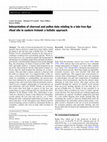
Vegetation History and Archaeobotany, 2006
The study of charcoal produced by five burning episodes that occurred in a rapid succession withi... more The study of charcoal produced by five burning episodes that occurred in a rapid succession within a ritual pit dating to the late Iron Age at Raffin Fort, Co. Meath, Ireland, reveals considerable variation in the charcoal assemblages resulting from each burning episode. Wood selection processes are considered against the background of information on woodland composition and land-use history provided by a detailed pollen diagram from nearby Emlagh Bog, the chronology of which is based on both AMS 14 C dates and tephra analysis. A human skull fragment lay on top of the charcoal layers but the radiocarbon evidence indicates that the skull predated the burnings by at least a century. This and other evidence indicate a ritual pit with the skull as a human relic. It is suggested that, in this instance, wood selection was neither random nor determined solely by availability or combustibility, but instead may have been informed by socio-religious belief systems pertaining to trees and wood. Early Irish documentary sources, which reveal a complex ethnography of wood and trees in later prehistoric and early historic Ireland, are reviewed. The results shed fresh light on aspects of late Iron Age archaeology in a part of Europe that was outside the direct influence of the Roman world. New information is provided on a distinctive feature in late Holocene Irish pollen records namely the Late Iron Age Lull (ca. a.d. 1-500). During this time, widespread regeneration of woody vegetation took place. In the subsequent early Medieval period renewed farming activity resulted in substantial decline in woodland, a pattern also seen at many other locations in Ireland.
Quaternary Science Reviews, 2007
This article was published in an Elsevier journal. The attached copy is furnished to the author f... more This article was published in an Elsevier journal. The attached copy is furnished to the author for non-commercial research and education use, including for instruction at the author's institution, sharing with colleagues and providing to institution administration. Other uses, including reproduction and distribution, or selling or licensing copies, or posting to personal, institutional or third party websites are prohibited. In most cases authors are permitted to post their version of the article (e.g. in Word or Tex form) to their personal website or institutional repository. Authors requiring further information regarding Elsevier's archiving and manuscript policies are encouraged to visit: http://www.elsevier.com/copyright
New Phytologist, 1987
S ummary Results of palaeoecological investigations on a core from Lough Sheeauns, NW Connemara, ... more S ummary Results of palaeoecological investigations on a core from Lough Sheeauns, NW Connemara, a small lake sited in an area with a dense concentration of megaliths datable to the Neolithic, are reported. Pollen analysis, involving continuous sampling over a 41 cm interval spanning the elm decline (c. 5000 BP), permitted a detailed reconstruction of the vegetational changes and the nature of human impact. The pollen data are supplemented by chemical analysis and a chronology is provided by radiocarbon dating.

Journal of the North Atlantic, 2008
Long-term environmental change and human impact have been reconstructed at fi ne spatial and temp... more Long-term environmental change and human impact have been reconstructed at fi ne spatial and temporal resolutions in an archaeologically rich, and fl oristically interesting, part of southwestern Ireland, namely the Beara peninsula, County Cork. Detailed pollen and macrofossil analyses, and radiocarbon dating have been carried out on several short peat monoliths, and on a peat core and a lake core from small basins. Landscape evolution, vegetation dynamics, and farming activity from the end of the Neolithic (c. 2500 B.C.) to the present day, i.e., the period of greatest human impact in southwestern Ireland, have been reconstructed. While signifi cant opening-up of the landscape began relatively early in the Bronze Age (between c. 2400-2100 B.C.), the main woodland clearances took place in the later Bronze Age (beginning c. 1400 B.C. and continuing into the Iron Age, i.e., to c. 400 B.C.). In the mid-and later Iron Age, there was considerable fi ne-scale spatial variation, with activity being concentrated mainly in the uplands (at c. 200 m asl) and at lower elevations. Radiocarbon dating and pollen evidence show that the linear stone-wall system, now partly obscured by shallow peat, was laid out towards the end of the Iron Age (c. A.D. 400) in the context of a largely open landscape. While the initial foci of bog growth appear to relate to the late Neolithic/beginning of the Bronze Age, widespread development of blanket bog was essentially a phenomenon of the late 1 st /early 2 nd millennium A.D. It was probably favoured by wetter and cooler conditions during the Little Ice Age. Detailed records are presented for the fi lmy ferns, Hymenophyllum tunbrigense, H. wilsonii, and Trichomanes speciosum, and also Myrica and Ulex, both shrubs with pronounced, oceanic distribution patterns.
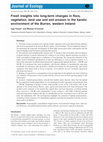
Journal of Ecology, 2009
1. The study focuses on species-rich, upland, heathy vegetation with arctic-alpine floristic affi... more 1. The study focuses on species-rich, upland, heathy vegetation with arctic-alpine floristic affinities and Sesleria grasslands in the karstic Burren region, western Ireland. The investigations aimed at reconstructing the long-term development of these high conservation-value communities and the role of farming in their formation and long-term survival. 2. The methods used included pollen analysis and 14 C-dating of short monoliths and investigation of grykes (fissures in karstic limestone) for evidence of soil erosion. Special attention was paid to fossil, coprophilous fungal spores as indicators of local grazing. The strong local character of the pollen records facilitated identification of inter-site differences as well as regional patterns. It is shown that open pine woodland characterized the Cappanawalla uplands between c. 1500 BC and 500 BC. It is proposed that such woodlands, with floristic affinities to Scandinavian open pine woodlands on calcareous soils, provided a suitable environment for the present-day, open heath vegetation with species such as Dryas octopetala, Arctostaphylos uva-ursi, Geranium sanguineum and Empetrum nigrum. 3. Burning of vegetation as a management tool was important in the uplands over most of the last two millennia. Firing seems to have ceased with the onset of more intensive grazing regimes in the 18th century. 4. Synthesis. Upland palaeoarchives, derived from shallow peaty deposits, show that the upland Burren supported mainly plagioclimax Corylus-dominated woody vegetation and grasslands from c. 1500 BC (beginning of present record), until possibly as late as the 17th century AD. In the uplands of the northwestern Burren, open, species-rich pinewoods with hazel dominated. The northern-arctic elements in the present-day upland flora survived clearances, involving initially Pinus sylvestris (c. 500 BC) and subsequently Corylus avellana (c. AD 1600). Colluvial material retrieved from grykes supports the idea of considerable soil loss occurring as late as the first and early 2nd millennium AD. The investigations highlight the potential of upland palaeoarchives, consisting of short sequences, for elucidating vegetation and land-use dynamics in karstic environments such as the Burren.
Environmental Protection Agency, 1999
EXECUTIVE SUMMARY• This project was undertaken with a view to providing comprehensive ecological ... more EXECUTIVE SUMMARY• This project was undertaken with a view to providing comprehensive ecological assessments of the status of six large western Irish lakes (Loughs Carrowmore, 960ha, Conn, 5000ha, Cullin, 1100ha, Carra, 1500ha, Mask, 8000ha and Corrib, 17000ha) and to make recommendations on how they might be monitored in future.

Detailed pollen records, derived from thick Late-glacial and post-glacial sediments collected at ... more Detailed pollen records, derived from thick Late-glacial and post-glacial sediments collected at An Loch Mór, a small but deep lake on Inis Oírr, Aran Islands, western Ireland provide new insights into post-glaciation, higher-plant colonisation in Ireland. In general, tall shrubs, including juniper and birch (other than Betula nana), did not survive the Younger Dryas cold period (c.12.85-11.65 ka, i.e. calibrated years BP) on Inis Oírr. Most woody species that subsequently constituted the post-glacial flora, spread, established and expanded during the Holocene. The sequence of establishment and expansion of woody plants in the early Holocene was juniper, followed by birch, then hazel and finally tall canopy trees, i.e. pine, and then oak and elm more or less simultaneously. There are substantial records for tall shrubs including Viburnum opulus and Rhamnus cathartica. The rather open character of the early post-glacial, tall-canopy woodlands is noteworthy. This favoured high biodive...




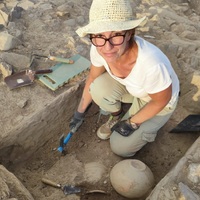




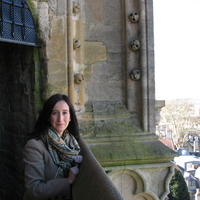

Uploads
Papers by Michael O'Connell
***
The volume arises from two conferences on the history of cattle in Ireland that were organised by the Agricultural History Society of Ireland (www.ahsi.ie)in 2014. The book complements and augments the considerable literature that already exists on the subject. The style is such that the book should prove accessible to a wide audience but yet be regarded as authoritative. Each contribution has a comprehensive reference list and some of the contributions have many footnotes that provide additional insights. There is a centrepiece of 64 pages devoted to high quality illustrations — many in colour — that include diagrams (several from old publications that are seldom seen), graphs and photographs. The book adopts an all-Ireland approach — as regards editorship, contributors and subject matter; that said, there is also much for those with a particular interest in western Ireland. There will be an official launch of the volume at the AHSI Summer Conference in the National Museum of Ireland, Country Life on the 11th June 2016 by Dr Lillis Ó Laoire of Scoil na Gaeilge, NUIG.